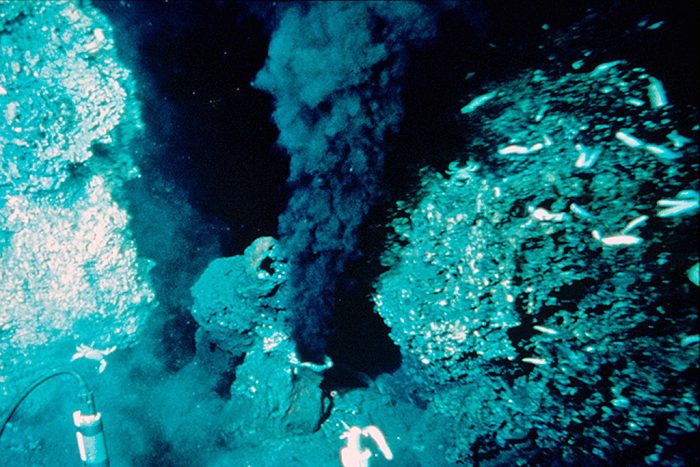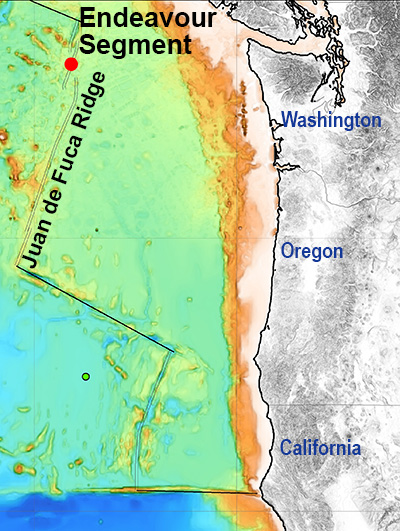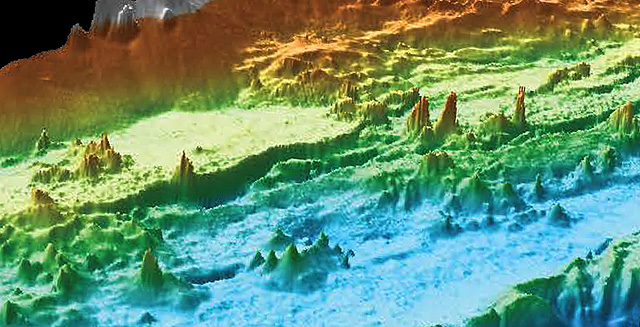Welcome back to our Science Odyssey Contest event, where we're posting STEM articles from May 2 to May 17. To enter the contest, you can find details at the bottom of this post.
On land, volcanoes are well known—and feared—for their destructive capabilities. But they are also prolific builders, creating fertile plains, giant mountains, even entire islands rising from the sea.
And speaking of the sea, volcanoes—and their close cousin, hydrothermal vents—are just as busy below the water. Down here, the mixing of super-heated gases, minerals and freezing-cold seawater creates incredible structures.
And now, thanks to an autonomous underwater vehicle (robot sub) of the Monterey Bay Aquarium Research Institute (MBARI), we're getting a window into this towering world. Hundreds of hydrothermal chimneys have been found on the seafloor of the Pacific Ocean off the coasts of BC and Washington state. The images look like a collection of skyscrapers dotting the seafloor.
What are hydrothermal chimneys?

A 'black smoker'—a hydrothermal vent shooting a dark, mineral-rich cloud into the ocean above. (Wikimedia Commons/W.R. Normark, Dudley Foster)
In places near volcanoes and the fault lines of tectonic plates, you'll often find hydrothermal vents. These are all openings in the Earth's crust—places where the magma (molten rock) of the mantle affects things near the surface.
In volcanoes, that magma erupts through the Earth's crust and becomes lava. But hydrothermal vents don't leak lava. Instead, the magma underneath just gets close enough to the surface to heat water trapped inside the bedrock, or foundation layer, of the ocean floor.
As a result, this mineral-rich, super-hot water is put under intense pressure, causing it to burst from the seafloor through holes called vents. The hydrothermal vents are known as a source of food for deep-sea life—hundreds and thousands of tiny shrimp and worms can be found clustered around them like diners at a restaurant buffet.
But these reactions also build structures, too: Hydrothermal chimneys!
Mighty minerals
On land, a geyser like Old Faithful at Yellowstone Park is similar to an underwater hydrothermal vent. (Getty Embed)
The key moment is when the superheated water (often over 300°C or 570°F) hits the freezing saltwater. This shocking collision causes minerals dissolved in the hot water to be released and deposited around the vent.
Hydrothermal chimneys are formed when these vents continue to deposit more and more of these minerals, until they climb upward into skinny structures that can be up to and over 25 metres (82 feet) tall—almost the height of a ten-floor building. These are what the MBARI robot sub discovered on the seafloor. And it found hundreds of them!
Underwater city

The robot mapped a place called the Endeavour Segment. This area experiences a lot of tectonic activity. (©2020 MBARI)
The field mapped by MBARI covered an area about 14 km (9 miles) long and 1.6 km (1 miles) wide. Within this, they found over 500 chimneys. Not all of these were giants. Most were about 6 metres (25 feet tall)—the height of an average two-floor home.
And many were no longer active. As the superheated water deposits minerals, sometimes the vent becomes clogged, leaving behind a 'dead' tower of rock. And often these towers crumble and collapse under their own weight and the pressure of the water around them.
But whether the chimneys are modest or colossal, alive or dead, this new study is a real eye opener. Normally, these towers are impossible to see in a haze of pitch black water and churned up sediment. Now, after 140 dives by the MBARI sub, sonar has mapped this spooky metropolis for all of us to see.
What an underwater world!
Contest alert
Don't miss our Science Odyssey Contest. Click HERE TO ENTER.

 This image shows part of the ocean floor that was studied. The colours represent height, with red being high and blue being low—several of the chimneys are found in the middle of the picture. (©2020 MBARI)
This image shows part of the ocean floor that was studied. The colours represent height, with red being high and blue being low—several of the chimneys are found in the middle of the picture. (©2020 MBARI)









